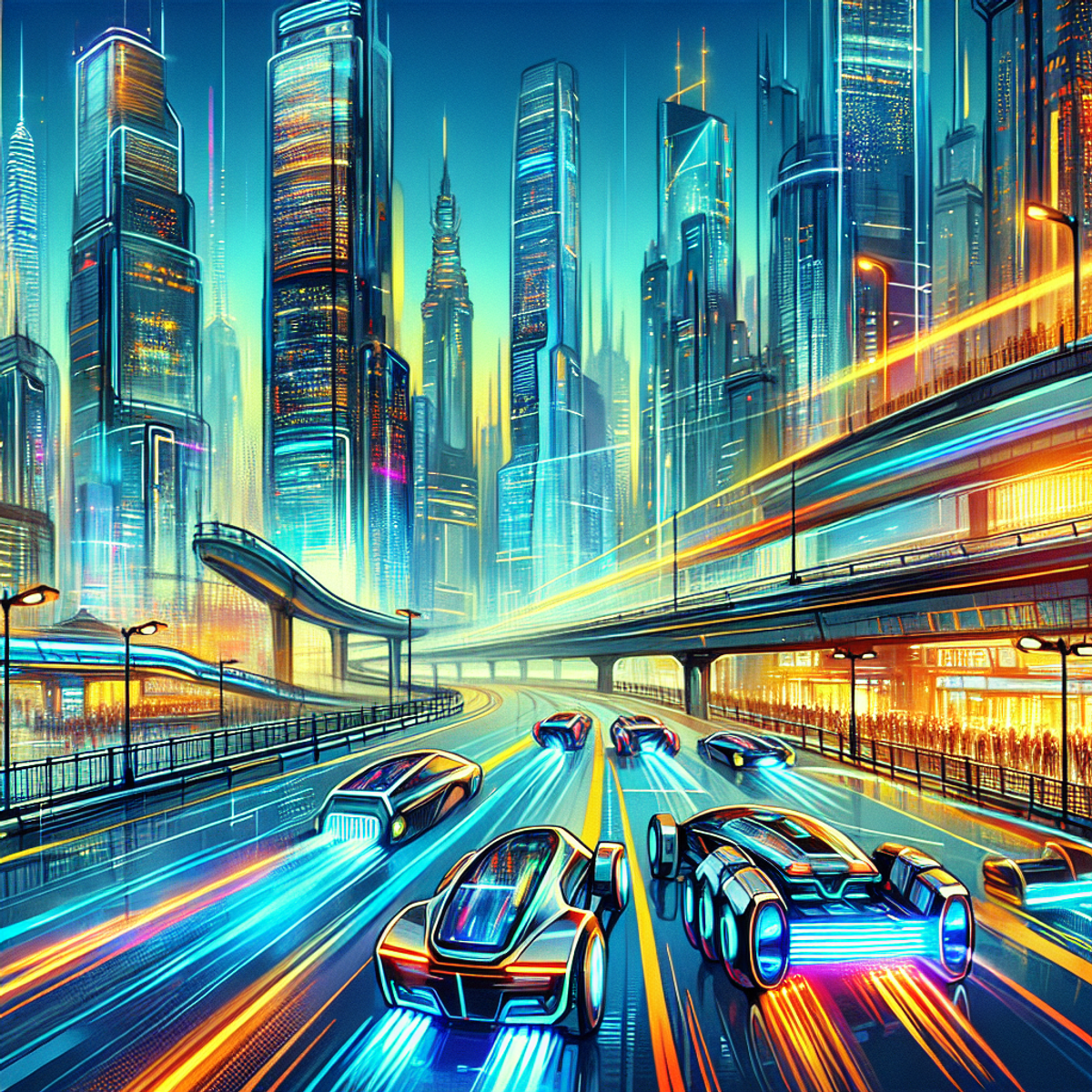Python in Smart Transportation: Traffic Prediction

Python in Smart Transportation: Traffic Prediction
Introduction
Smart transportation is a complex system that integrates various technologies to improve the efficiency and safety of transportation networks. It encompasses components such as traffic management, vehicle monitoring, and infrastructure optimization.
Accurate traffic prediction plays a pivotal role in the optimization of smart transportation systems. By using Python for traffic prediction, we can leverage machine learning and deep learning models to predict traffic flow, congestion, and travel times. This capability allows us to make proactive decisions for route planning, adaptive signal control, and dynamic rerouting.
In the context of smart transportation, Python is a versatile tool for developing predictive models that help reduce emissions through optimized traffic patterns. The importance of Python in traffic prediction lies in its ability to handle large amounts of historical traffic data, uncover valuable insights, and support real-time decision-making systems.
In this article, we will explore various methods of Python-based traffic prediction and discover how this programming language can shape the future of intelligent transportation systems.
Traffic Prediction with Machine Learning Models
Traffic prediction is crucial for optimizing smart transportation systems. By accurately predicting traffic flow, we can enable efficient route planning and implement effective traffic management strategies. Machine learning models have become powerful tools for traffic flow prediction, offering valuable insights into traffic patterns and enabling proactive decision-making. In this section, we will explore the significance of traffic flow prediction and discuss the common techniques used for this task using machine learning models.
Traffic Flow Prediction
Traffic flow prediction is essential for optimizing smart transportation systems. By forecasting future traffic conditions, we can develop strategies to reduce congestion, improve travel time, and enhance overall traffic management. Machine learning models provide an effective way to perform traffic flow prediction by analyzing historical data and identifying patterns and trends.
There are several techniques commonly used for traffic flow prediction with machine learning models:
- Time-series Analysis: Time-series analysis is widely used for traffic flow prediction. It involves analyzing historical traffic data collected at regular intervals to identify patterns and trends over time. Machine learning algorithms such as ARIMA (AutoRegressive Integrated Moving Average) and SARIMA (Seasonal AutoRegressive Integrated Moving Average) are often used for time-series analysis in traffic prediction.
- Regression Models: Regression models offer a way to estimate the relationship between input variables (e.g., weather conditions, time of day, road characteristics) and the target variable (traffic flow). Techniques like linear regression, decision trees, and random forests can be applied to construct predictive models for traffic flow.
- Neural Networks: Neural networks, especially Long Short-Term Memory (LSTM) networks, have shown promising results in traffic flow prediction. LSTM networks are capable of capturing long-term dependencies in sequential data and have been successful in forecasting future traffic conditions based on historical data. Recent studies have highlighted the effectiveness of LSTM networks in traffic flow prediction.
These techniques can be combined or used individually depending on the specific requirements of the traffic prediction task. The choice of technique depends on factors such as data availability, computational resources, and desired prediction accuracy.
Real-World Applications
Traffic flow prediction using machine learning models has found numerous applications in smart transportation systems. Let's take a look at a few real-world examples:
- Route Planning: Accurate traffic flow prediction enables efficient route planning by considering current and predicted traffic conditions. Navigation systems can use machine learning models to suggest optimal routes that minimize travel time and avoid congested areas. This helps drivers save time and reduces overall traffic congestion.
- Traffic Management: Traffic flow prediction plays a vital role in traffic management strategies. By accurately predicting traffic patterns, authorities can proactively implement measures such as adaptive signal control and dynamic rerouting to mitigate congestion and improve traffic flow. Machine learning models provide valuable insights for optimizing traffic signal timings and dynamically adjusting routes based on real-time traffic conditions.
- Emergency Response: Timely traffic flow prediction is crucial for emergency response services. By accurately forecasting traffic conditions, emergency vehicles can be directed along the most efficient routes, ensuring faster response times. Machine learning models contribute to effective emergency response planning by providing real-time insights into traffic patterns. For example, this study
Congestion Alerts and Travel Time Reduction
Machine learning models are essential for predicting traffic in smart transportation systems. They help with various aspects of traffic management, including congestion alerts and travel time reduction.
Importance of timely congestion alerts:
- Timely congestion alerts are crucial for proactive traffic management in smart cities.
- By accurately predicting traffic flow patterns, machine learning models can identify potential areas of congestion before they occur.
- This enables transportation authorities to take proactive measures such as adjusting signal timings or implementing dynamic rerouting strategies to alleviate congestion.
- Congestion alerts help reduce the overall traffic volume and improve the efficiency of the transportation network.
How machine learning models help reduce travel time:
- Machine learning models can analyze historical traffic data to understand traffic patterns, including peak hours and congested routes.
- By combining this information with real-time data from sensors and GPS devices, these models can predict travel times more accurately.
- Adaptive signal control systems use machine learning algorithms to dynamically adjust traffic signals based on current traffic conditions.
- This helps optimize the flow of vehicles through intersections, reducing delays and travel times.
- Dynamic rerouting algorithms leverage machine learning techniques to suggest alternate routes in real-time, considering factors such as current traffic conditions and predicted congestion.
Pros and cons of using machine learning models for traffic prediction in smart cities:
Pros:
- Machine learning models can handle large amounts of data and extract meaningful patterns, allowing for accurate prediction of traffic flow.
- These models can adapt to changing conditions and continuously improve their accuracy over time.
- By enabling proactive management strategies, machine learning-based traffic prediction systems can significantly reduce congestion and travel times.
Cons:
- Developing accurate machine learning models requires extensive training on historical data, which can be time-consuming and computationally expensive.
- The accuracy of predictions heavily relies on the quality and availability of data sources, including real-time sensor data.
- Implementation and maintenance costs may be a barrier for some cities, as it requires investment in infrastructure and technology.
Machine learning models have a significant impact on congestion alerts and travel time reduction in smart transportation systems. By using historical and real-time data, these models enable proactive traffic management strategies such as adaptive signal control and dynamic rerouting. While there are challenges associated with developing and implementing these models, the benefits in terms of reduced congestion and improved travel times make them invaluable tools for smart cities.
Emissions Reduction through Optimized Traffic Patterns
Traffic congestion not only causes delays and frustration for commuters but also has a significant environmental impact. The increased number of vehicles on the road leads to higher air pollution and carbon emissions, contributing to climate change and health issues. However, machine learning models have emerged as powerful tools for optimizing traffic patterns and reducing vehicle emissions in smart transportation systems.
The Environmental Impact of Traffic Congestion on Air Pollution and Carbon Emissions
Traffic congestion creates a domino effect, with idling vehicles releasing pollutants into the atmosphere. The emissions from cars, trucks, and buses include nitrogen oxides (NOx), volatile organic compounds (VOCs), and particulate matter (PM). These pollutants contribute to air pollution, which can have severe consequences for public health.
Moreover, the continuous stop-and-go traffic in congested areas leads to inefficient fuel consumption and increased carbon emissions. As vehicles spend more time on the road due to congestion, their energy efficiency decreases, resulting in higher greenhouse gas emissions. This further exacerbates the environmental challenges we face today.
Role of Machine Learning Models in Optimizing Traffic Patterns for Minimizing Vehicle Emissions
Machine learning models play a crucial role in optimizing traffic patterns to reduce vehicle emissions. These models analyze historical traffic data, real-time sensor data, and other relevant factors to predict traffic flow patterns accurately. By understanding traffic patterns, transportation authorities can implement strategies to minimize congestion and improve overall traffic efficiency.
1. Identifying Congestion Hotspots
Through machine learning-based traffic prediction models, transportation planners can identify areas prone to congestion and develop targeted solutions. For example, they can optimize signal timings at intersections based on predicted traffic flow to minimize unnecessary stops and reduce vehicle idling. By synchronizing signals intelligently, machine learning models enable smoother traffic flow and reduce emissions caused by frequent acceleration and deceleration.
2. Dynamic Routing for Efficient Travel
Furthermore, machine learning models can help in dynamic routing by considering real-time traffic conditions. By rerouting vehicles away from congested areas, these models can help reduce the time spent in traffic and, consequently, lower emissions. This dynamic rerouting approach ensures that vehicles take the most efficient and least congested routes, minimizing their overall environmental impact.
3. Managing Special Events and Peak Hours
Machine learning models can also contribute to emissions reduction by optimizing traffic patterns during special events or peak hours. By predicting traffic demand accurately, transportation authorities can plan alternative transportation options such as public transit or encourage carpooling to reduce the number of vehicles on the road. These proactive measures help alleviate congestion and reduce emissions during high-demand periods.
Pros and Cons of Leveraging Machine Learning Models for Traffic Prediction in Smart Cities
While machine learning models offer significant benefits for optimizing traffic patterns and reducing emissions, it is essential to consider their pros and cons:
Pros:
- Machine learning models provide accurate predictions of traffic flow, enabling proactive measures to reduce congestion and emissions.
- Optimization of traffic patterns through machine learning models improves fuel efficiency and reduces carbon emissions.
- Real-time monitoring and adaptive strategies based on machine learning help transportation authorities respond quickly to changing traffic conditions.
Cons:
- The effectiveness of machine learning models heavily relies on the availability of high-quality data. Inaccurate or incomplete data can lead to less reliable predictions.
- Developing and training machine learning models require substantial computational resources.
- Privacy concerns may arise when collecting and analyzing large amounts of personal data for traffic prediction purposes.
Despite these challenges, the potential benefits of leveraging machine learning models for optimizing traffic patterns and reducing vehicle emissions in smart cities are significant. By using advanced algorithms and historical data, Python-based machine learning frameworks provide a powerful toolkit for transportation planners to create more sustainable and efficient urban environments.
Deep Learning Models for Enhanced Traffic Prediction
Deep learning models have become powerful tools for improving traffic prediction in smart transportation systems. These models, especially pretrained large language models (LLMs), offer effective and precise prediction abilities that can greatly enhance traffic management strategies. In this section, we will look at the use of deep learning models, specifically pretrained LLMs, for traffic prediction and discuss their advantages and limitations.
Pretrained Large Language Models (LLMs) for Efficient and Accurate Prediction
One of the recent advancements in deep learning is the development of pretrained LLMs such as GPT-3 (Generative Pretrained Transformer 3) and BERT (Bidirectional Encoder Representations from Transformers). These models have been trained on massive amounts of text data and can generate high-quality predictions based on patterns learned from the data.
Exploring pretrained LLMs and their suitability for traffic prediction tasks
Pretrained LLMs have shown great potential in various natural language processing tasks, such as language translation, sentiment analysis, and text generation. Their ability to understand and generate human-like text makes them well-suited for analyzing and predicting traffic patterns.
In the context of traffic prediction, pretrained LLMs can be fine-tuned on historical traffic data to learn the complex relationships between various factors affecting traffic flow. By leveraging the contextual information encoded in these models, they can capture both spatial and temporal dependencies in traffic patterns, leading to more accurate predictions.
Benefits of using pretrained LLMs in smart transportation systems
The use of pretrained LLMs offers several benefits for traffic prediction in smart transportation systems:
- Efficiency: Pretrained LLMs provide a time-efficient solution for traffic prediction as they eliminate the need for training models from scratch. Their pretraining process allows them to quickly adapt to specific tasks with minimal fine-tuning.
- Accuracy: Due to their large-scale pretraining on diverse language data, pretrained LLMs have a strong understanding of semantic relationships and can capture subtle patterns in traffic data. This enables them to make accurate predictions about traffic flow and congestion.
- Generalization: Pretrained LLMs can generalize well to unseen traffic scenarios and adapt to dynamic changes in traffic patterns. This flexibility makes them suitable for handling real-time traffic prediction tasks, where the availability of up-to-date information is crucial.
Limitations of using pretrained LLMs for traffic prediction
While pretrained LLMs offer significant advantages, they also have limitations that need to be considered:
- Data requirements: Fine-tuning pretrained LLMs for traffic prediction requires a substantial amount of labeled historical traffic data. Acquiring such data can be challenging, especially when considering the availability of high-quality labeled datasets that cover diverse geographical regions and different types of transportation systems.
- Domain-specific knowledge: Pretrained LLMs may lack domain-specific knowledge related to transportation systems. For example, they might not be aware of specific road network structures or local driving behaviors. Incorporating this knowledge into pretrained LLMs can be a complex task that requires careful engineering and feature representation.
- Computational resources: Pretrained LLMs are computationally expensive models that require powerful hardware resources for training and inference. Deploying these models in resource-constrained environments, such as embedded systems or edge devices, may pose challenges due to their high memory and processing requirements.
Despite these limitations, the use of pretrained LLMs holds immense promise for enhancing traffic prediction in smart transportation systems. By leveraging their efficiency and accuracy, researchers and practitioners can develop advanced traffic management strategies that optimize route planning, reduce travel time, and minimize environmental impact.
Challenges in Training Deep Learning Models with Historical Traffic Data

1. Complexity of Spatiotemporal Data
Historical traffic data is inherently complex, involving intricate spatial and temporal patterns that traditional machine learning approaches may struggle to capture effectively.
2. Data Scarcity and Imbalance
Limited availability of diverse and balanced historical traffic data can hinder the ability to train deep learning models comprehensively, leading to potential biases and inaccuracies.
3. Computational Resources
The resource-intensive nature of training deep learning models with large-scale historical traffic datasets can pose significant computational challenges, requiring substantial processing power and memory.
Strategies to Enhance the Training Process
To address these challenges, several strategies can be employed to enhance the training process:
1. Data Augmentation
By leveraging techniques such as synthetic data generation, temporal expansion, and spatial interpolation, data augmentation can help enrich the existing historical traffic dataset, mitigating issues related to data scarcity and imbalance.
2. Transfer Learning
Utilizing pre-trained deep learning models or specific layers from existing models can expedite the training process and improve the generalization capabilities of the model when confronted with limited historical traffic data.
These solutions empower practitioners to navigate the complexities associated with training deep learning models for traffic prediction while maximizing the effectiveness and efficiency of model training.
By understanding the advancements offered by deep learning models in the field of traffic prediction and leveraging innovative strategies to overcome inherent challenges, such as data scarcity and computational demands, the application of deep learning holds immense promise in shaping the future of intelligent transportation systems.
TPLLM: A Traffic Prediction Framework Leveraging Pretrained LLMs
Deep learning models have revolutionized the field of traffic prediction, enabling more accurate and efficient forecasting of traffic patterns. One such framework that leverages the power of deep learning is TPLLM (Traffic Prediction Leveraging Pretrained Large Language Models). TPLLM provides a comprehensive solution for accurate traffic prediction by integrating graph-structured spatial information and employing a parameter-efficient fine-tuning approach.
Comprehensive Overview of the TPLLM Framework
TPLLM combines the capabilities of pretrained large language models (LLMs) with graph-structured spatial information to enhance traffic prediction accuracy. This framework takes advantage of the pretraining process of LLMs, which involves training on large amounts of text data to learn general language patterns and representations. By fine-tuning these pretrained models on traffic data, TPLLM can effectively capture the complex spatiotemporal patterns inherent in traffic flow.
The TPLLM framework consists of several key components:
- Graph-structured spatial information: TPLLM incorporates graph structures to capture the spatial relationships between different locations in a road network. This allows the model to learn the dependencies between adjacent road segments and their impact on traffic flow. By considering the graph structure, TPLLM can effectively model the dynamic nature of traffic patterns and make accurate predictions.
- Parameter-efficient fine-tuning approach: Fine-tuning deep learning models on traffic data can be computationally expensive and time-consuming. TPLLM addresses this challenge by employing a parameter-efficient fine-tuning approach. This technique focuses on updating only a subset of model parameters that are most relevant to the task at hand, reducing the computational burden while maintaining prediction accuracy.
Advantages of TPLLM over Traditional Machine Learning Approaches
Understanding the advancements offered by deep learning models in the field of traffic prediction is crucial for grasping the benefits provided by frameworks like TPLLM. Here are some advantages of TPLLM and deep learning models over traditional machine learning approaches:
- Handling complex spatiotemporal data: Traffic prediction involves analyzing complex spatiotemporal data, such as traffic volume, speed, and historical patterns. Deep learning models, including TPLLM, excel at capturing intricate relationships within this type of data, allowing for more accurate predictions compared to traditional machine learning approaches.
- Automatic feature extraction: Deep learning models automatically learn relevant features from raw data, eliminating the need for manual feature engineering. This capability is especially valuable in traffic prediction tasks where the relationships between input variables can be nonlinear and difficult to define explicitly.
- Scalability: Deep learning models can scale to large datasets and handle high-dimensional input data effectively. This scalability enables TPLLM to process vast amounts of traffic-related information and capture fine-grained details about traffic patterns.
By leveraging these advantages, TPLLM offers a robust framework for accurate traffic prediction in smart transportation systems. Its incorporation of graph-structured spatial information and parameter-efficient fine-tuning approach sets it apart from traditional machine learning approaches and makes it a powerful tool for optimizing traffic management strategies.
To further explore this topic, you may find these resources helpful: [Journal of Big Data article on the TPLLM framework](https://journalofbigdata.springeropen.com/articles/10.1186
Python Source Code for Traffic Prediction
When it comes to implementing traffic prediction models in Python, there are several libraries and tools that can be utilized to build efficient and accurate solutions. Python's versatility and extensive libraries make it a popular choice for developing traffic prediction systems. Below are some key aspects related to the implementation of Python source code for traffic prediction:
Data Collection and Preprocessing
- Utilize libraries such as Pandas and NumPy for data collection, manipulation, and preprocessing.
- Use APIs to fetch real-time traffic data from sources like Google Maps or public transportation authorities.
- Clean and preprocess the data to handle missing values, outliers, and inconsistencies.
Feature Engineering
- Leverage libraries like Scikit-learn for feature extraction and engineering.
- Extract relevant features such as historical traffic patterns, weather conditions, road infrastructure, and special events.
- Transform the data into a suitable format for model training and evaluation.
Model Development
- Employ machine learning frameworks such as Scikit-learn, TensorFlow, or PyTorch for building traffic prediction models.
- Experiment with various algorithms including regression models, decision trees, random forests, or gradient boosting machines.
- Utilize deep learning architectures like recurrent neural networks (RNNs) or convolutional neural networks (CNNs) for capturing temporal and spatial patterns in traffic data.
Model Evaluation and Validation
- Use Python libraries like Scikit-learn and TensorFlow to evaluate model performance through metrics such as mean absolute error (MAE), root mean square error (RMSE), or coefficient of determination (R-squared).
- Employ cross-validation techniques to assess the robustness of the trained models.
- Validate the models using historical data and real-time traffic observations.
Visualization and Interpretation
- Leverage visualization libraries like Matplotlib, Seaborn, or Plotly for displaying traffic patterns, predicted values, and model performance metrics.
- Generate intuitive visualizations such as time series plots, heatmaps, or interactive dashboards to interpret model predictions.
- Communicate insights derived from the models to stakeholders through clear and informative visual representations.
Deployment
- Utilize Python frameworks like Flask or Django for deploying traffic prediction models as web services or APIs.
- Integrate the deployed models with smart transportation systems, navigation applications, or urban planning tools.
Python's rich ecosystem of libraries facilitates the end-to-end development of traffic prediction systems. From data collection and preprocessing to model development, evaluation, and deployment, Python offers comprehensive support for building effective solutions in the domain of smart transportation.
By leveraging Python's capabilities alongside advanced machine learning and deep learning techniques, developers can contribute to the advancement of intelligent transportation systems by providing accurate traffic predictions that enable efficient route planning, proactive congestion management, reduced travel times, optimized environmental impact. Additionally, incorporating methodologies highlighted in this research paper on traffic prediction can further enhance the accuracy and efficiency of these systems.
The Future of Traffic Prediction with Python
Python has been leading the way in driving improvements in traffic prediction technology in smart transportation. As the field continues to develop, Python and its libraries are expected to have a crucial role in shaping the future of traffic prediction.
Expected Technological Improvements
- Integration of Real-time Data: Python's flexibility and strength make it ideal for incorporating real-time data sources into traffic prediction models. This integration is expected to result in more accurate and responsive traffic forecasts, allowing for proactive management of transportation networks.
- Improved Deep Learning Models: With ongoing advancements in deep learning frameworks like TensorFlow and PyTorch, Python is set to make it easier to create and use advanced deep learning models for traffic prediction. These models will be able to handle complex spatiotemporal data, leading to better accuracy and reliability.
- Graph Neural Networks (GNNs) for Spatial Analysis: The use of GNNs, made possible by Python libraries such as DGL and PyTorch Geometric, shows promise for better spatial analysis in traffic prediction. This approach is expected to provide a deeper understanding of spatial relationships within transportation networks, resulting in more effective predictive models.
- Scalable Cloud Computing: Python's smooth integration with cloud computing platforms like AWS, Azure, and Google Cloud positions it as a key facilitator for scalable traffic prediction solutions. This integration will enable the processing of large-scale traffic data, paving the way for more comprehensive and accurate predictions.
Ecosystem Development
Python's open-source nature and thriving community contribute to the continuous improvement of libraries and tools designed for traffic prediction applications:
- Expansion of Geospatial Libraries: Python offers a wide range of geospatial libraries such as GeoPandas, Shapely, and Folium. The ongoing expansion and refinement of these libraries are expected to enhance the capabilities for geospatial analysis in traffic prediction tasks.
- Advancements in Time Series Forecasting: With libraries like Prophet and Statsmodels gaining popularity, Python's time series forecasting capabilities are expected to improve further. This development will lead to more advanced methods for analyzing historical traffic patterns and making accurate predictions.
- Deployment Automation with Containers: The adoption of containerization technologies like Docker and Kubernetes within Python-based applications is expected to simplify the deployment process for traffic prediction models. This automation will contribute to increased efficiency and reliability in real-world implementations.
Collaborative Innovation
Python's widespread use in academia, industry, and research institutions encourages collaborative innovation in traffic prediction:
- Knowledge Sharing in Open Source Communities: Platforms such as GitHub and Kaggle provide fertile ground for collaboration among data scientists and researchers working on traffic prediction projects using Python. This collaborative environment speeds up the sharing of best practices and new approaches.
- Cross-Domain Integration: Python's versatility promotes integration across different fields, making it easier to transfer knowledge from areas like meteorology, urban planning, and environmental science into traffic prediction efforts. This interdisciplinary approach is expected to result in comprehensive insights into transportation dynamics.
The future of traffic prediction with Python is set to see significant improvements driven by technological advancements, ecosystem development, and collaborative efforts across various domains. As Python continues to develop as a fundamental part of intelligent transportation systems, it has great potential to transform the efficiency and sustainability of future transportation networks.
Conclusion
Python plays a crucial role in the field of smart transportation, especially in traffic prediction. Its versatility, ease of use, and vast array of libraries make it an ideal choice for developing and implementing intelligent transportation systems.
By using machine learning and deep learning models in Python, we can accurately predict traffic patterns. This leads to several benefits:
- Optimized route planning
- Proactive traffic management
- Reduced travel time
- Minimized vehicle emissions
The future of traffic prediction looks promising with Python at the forefront. As advancements continue to be made in Python's ecosystem of libraries and frameworks, we can expect even more sophisticated and efficient traffic prediction models to emerge. These advancements will further enhance the capabilities of intelligent transportation systems, making them more adaptive, responsive, and environmentally friendly.
To fully explore the potential of Python in shaping the future of smart transportation, specifically in the field of traffic prediction, I encourage you to:
- Dive into the vast collection of Python libraries such as scikit-learn, TensorFlow, and PyTorch that provide powerful tools for machine learning and deep learning.
- Stay updated with the latest research and developments in traffic prediction algorithms and techniques.
- Engage with the Python community through forums, conferences, and online tutorials to learn from experts and share your insights.
- Experiment with real-world datasets to gain hands-on experience in building traffic prediction models using Python.
By embracing Python's capabilities and pushing its boundaries in smart transportation applications like traffic prediction, we can contribute to creating more efficient, sustainable, and safer transportation systems for the future.
FAQs (Frequently Asked Questions)
What is the significance of accurate traffic prediction in optimizing smart transportation systems?
Accurate traffic prediction plays a crucial role in optimizing smart transportation systems by enabling efficient route planning, proactive traffic management strategies, and reduction of travel time and vehicle emissions.
What are some common techniques employed for performing traffic flow prediction using machine learning models?
Common techniques for performing traffic flow prediction using machine learning models include time series analysis, recurrent neural networks (RNN), convolutional neural networks (CNN), and graph-structured spatial information integration.
How do machine learning models contribute to traffic prediction in smart transportation systems?
Machine learning models contribute to traffic prediction in smart transportation systems by providing congestion alerts, aiding in reducing travel time through adaptive signal control and dynamic rerouting, and optimizing traffic patterns for minimizing vehicle emissions.
What are pretrained large language models (LLMs) and how are they suitable for efficient and accurate traffic prediction tasks?
Pretrained large language models (LLMs) are advanced deep learning models that have been trained on vast amounts of textual data. They are suitable for efficient and accurate traffic prediction tasks due to their ability to understand complex spatiotemporal data patterns and make accurate predictions based on historical traffic data.
What are the anticipated advancements in traffic prediction technology driven by Python and its ecosystem of libraries?
The future of traffic prediction with Python is anticipated to bring advancements such as enhanced deep learning models, improved pretrained LLMs integration, and more efficient frameworks for accurate traffic prediction leveraging the capabilities of Python's rich ecosystem of libraries.
How does the TPLLM framework contribute to accurate traffic prediction using pretrained LLMs?
The TPLLM framework contributes to accurate traffic prediction using pretrained LLMs by integrating graph-structured spatial information and employing a parameter-efficient fine-tuning approach. This comprehensive approach enhances the accuracy and efficiency of traffic prediction tasks.

Comments
Post a Comment